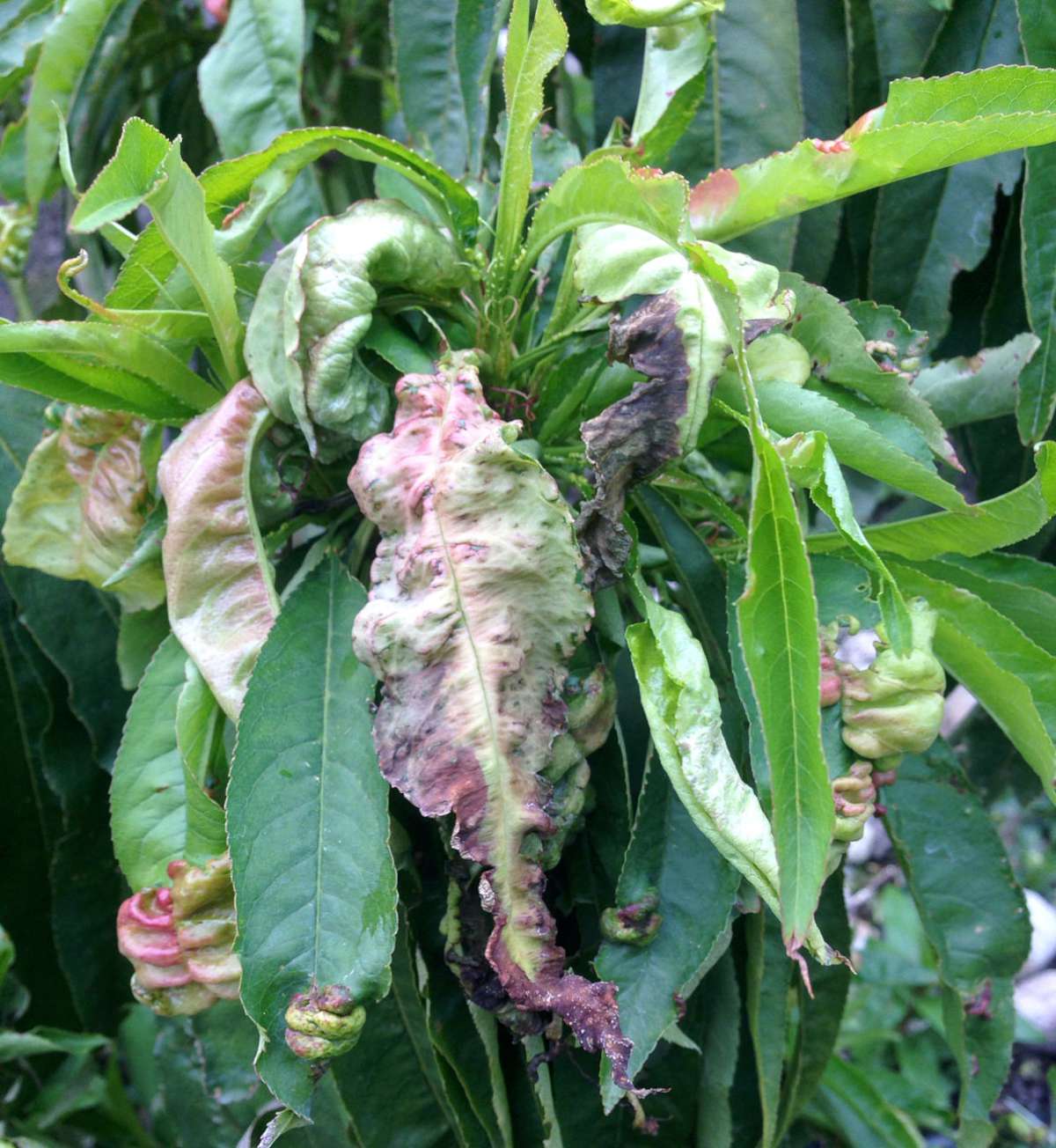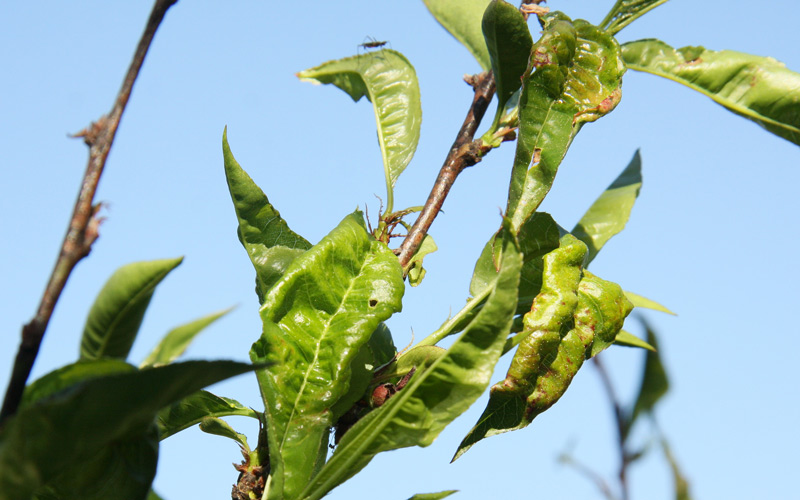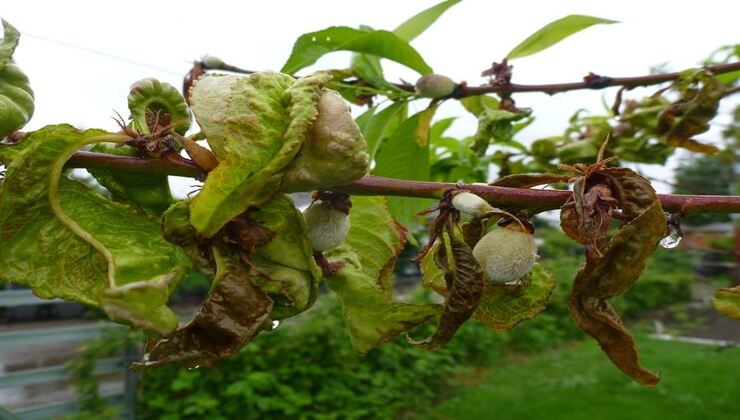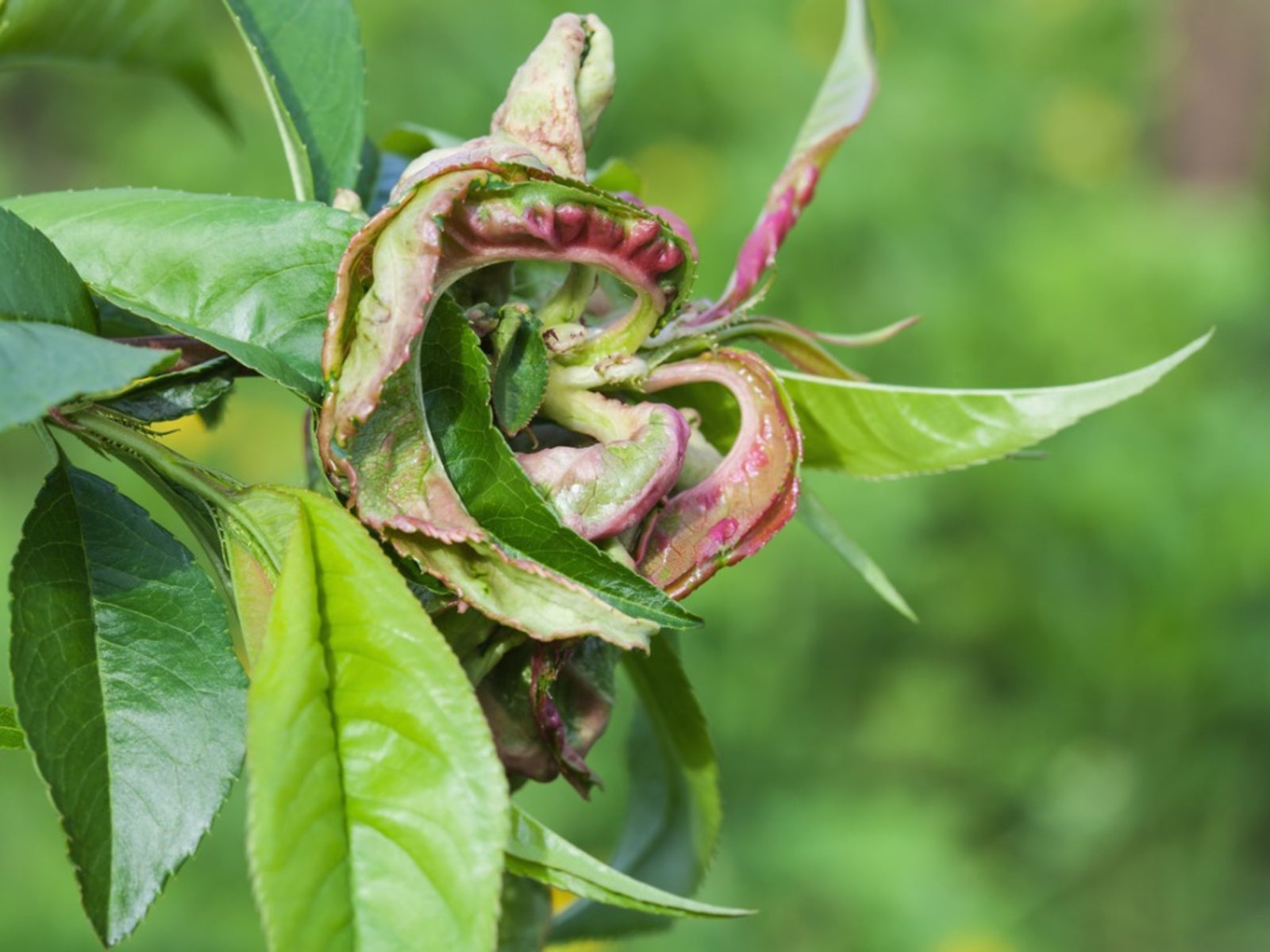Understanding the Causes of Peach Leaf Curl
Peach leaf curl is a common disease affecting peach trees, caused by the fungus Taphrina deformans. This fungus infects the leaves of peach trees, causing them to become curled, distorted, or discolored. The disease can lead to reduced fruit production, weakened trees, and increased susceptibility to other diseases and pests. Identifying the problem early is crucial to prevent further damage and ensure effective treatment for peach leaf curl.
The fungus Taphrina deformans overwinters on the tree’s buds and twigs, and in the spring, it infects the newly emerging leaves. The infection causes the leaves to become curled, puckered, or distorted, often with a reddish or yellowish color. As the disease progresses, the leaves may drop prematurely, reducing the tree’s ability to photosynthesize and produce fruit.
Several factors contribute to the development of peach leaf curl, including cool and wet weather, poor air circulation, and inadequate tree care. Trees that are stressed or weakened by other factors, such as nutrient deficiencies or pests, are more susceptible to the disease. Understanding the causes of peach leaf curl is essential for developing effective treatment and prevention strategies.
Early identification of peach leaf curl is critical for effective treatment. Regular inspections of the tree’s leaves and branches can help detect the disease in its early stages. By recognizing the symptoms and taking prompt action, growers can prevent the disease from spreading and reduce the risk of further damage. Effective treatment for peach leaf curl requires a comprehensive approach, including cultural practices, fungicides, and integrated pest management strategies.
How to Identify Peach Leaf Curl: Symptoms and Signs
Peach leaf curl can be identified by its distinctive symptoms, which can vary depending on the severity of the infection. The most common signs of peach leaf curl include:
Curled or distorted leaves: Infected leaves may become curled, puckered, or distorted, often with a reddish or yellowish color. The leaves may also become thickened and rigid.
Discolored leaves: Leaves may turn yellow, red, or purple, and may develop a powdery or dusty appearance.
Premature defoliation: Infected leaves may drop prematurely, reducing the tree’s ability to photosynthesize and produce fruit.
To inspect your peach trees for signs of peach leaf curl, follow these steps:
Regularly inspect the leaves and branches of your peach trees, especially during the spring and early summer when the disease is most active.
Look for curled, distorted, or discolored leaves, and check for premature defoliation.
Inspect the tree’s buds and twigs for signs of fungal growth, such as a white, cottony substance.
Check for other signs of disease, such as black spots or powdery mildew.
Early identification of peach leaf curl is critical for effective treatment. By recognizing the symptoms and taking prompt action, growers can prevent the disease from spreading and reduce the risk of further damage. Effective treatment for peach leaf curl requires a comprehensive approach, including cultural practices, fungicides, and integrated pest management strategies.
It’s essential to note that peach leaf curl can be mistaken for other diseases or pests, such as powdery mildew or aphids. Accurate diagnosis is crucial for effective treatment, so if you’re unsure about the identity of the disease, consult with a gardening expert or take a sample to a laboratory for analysis.
Organic and Chemical Treatment Options for Peach Leaf Curl
Once peach leaf curl has been identified, it’s essential to take prompt action to prevent the disease from spreading and reduce the risk of further damage. There are various treatment options available, including organic and chemical methods.
Organic treatment options for peach leaf curl include copper-based fungicides, such as Liqui-Cop or Copper-Count-N. These products are available at most gardening stores and can be applied according to the product’s instructions. Copper-based fungicides work by preventing the fungus from producing spores, thereby reducing the risk of infection.
Chemical treatment options for peach leaf curl include chlorothalonil-based fungicides, such as Daconil or Chlorothalonil 720. These products are also available at most gardening stores and can be applied according to the product’s instructions. Chlorothalonil-based fungicides work by killing the fungus on contact, thereby reducing the risk of infection.
When using fungicides to treat peach leaf curl, it’s essential to follow the product’s instructions carefully. This includes applying the fungicide at the correct dosage and timing, as well as taking necessary precautions to avoid exposure.
In addition to fungicides, other treatment options for peach leaf curl include removing infected leaves and branches, and providing adequate nutrition to the tree. This can help to promote healthy growth and reduce the risk of further infection.
It’s also important to note that treatment for peach leaf curl should be part of a comprehensive management plan. This includes maintaining good sanitation, pruning infected branches, and providing adequate nutrition to the tree. By taking a holistic approach to managing peach leaf curl, growers can reduce the risk of further damage and promote healthy growth.
When choosing a treatment option for peach leaf curl, it’s essential to consider the specific needs of your peach trees. This includes taking into account the severity of the infection, the time of year, and the overall health of the tree. By choosing the right treatment option and following the product’s instructions carefully, growers can effectively manage peach leaf curl and promote healthy growth.
Prevention is Key: Cultural Practices to Prevent Peach Leaf Curl
Preventing peach leaf curl requires a combination of good cultural practices and effective treatment options. By maintaining good sanitation, pruning infected branches, and providing adequate nutrition to the tree, growers can reduce the risk of infection and promote healthy growth.
Good sanitation is essential for preventing peach leaf curl. This includes removing any infected leaves or branches, as well as disposing of any debris that may be harboring the fungus. Regularly cleaning and disinfecting gardening tools and equipment can also help to prevent the spread of the disease.
Pruning infected branches is also crucial for preventing peach leaf curl. This includes removing any branches that show signs of infection, as well as thinning out the tree to improve air circulation and reduce humidity. Pruning should be done in the late winter or early spring, before new growth begins.
Providing adequate nutrition to the tree is also important for preventing peach leaf curl. This includes fertilizing the tree regularly, as well as ensuring that the soil is well-draining and rich in organic matter. A balanced fertilizer that is high in nitrogen, phosphorus, and potassium can help to promote healthy growth and reduce the risk of infection.
In addition to these cultural practices, growers can also use integrated pest management (IPM) strategies to prevent peach leaf curl. This includes using a combination of techniques, such as introducing beneficial insects, practicing good sanitation, and using fungicides as needed.
By combining these cultural practices with effective treatment options, growers can reduce the risk of peach leaf curl and promote healthy growth. Regular monitoring and maintenance are also essential for preventing the recurrence of the disease, and for ensuring that the tree remains healthy and productive.
It’s also important to note that prevention is key when it comes to peach leaf curl. By taking proactive steps to prevent the disease, growers can avoid the need for costly and time-consuming treatments. By maintaining good cultural practices and using effective treatment options, growers can ensure that their peach trees remain healthy and productive for years to come.
How to Apply Fungicides for Effective Treatment
When it comes to treating peach leaf curl, fungicides can be an effective solution. However, it’s essential to apply them correctly to ensure optimal results. Here’s a step-by-step guide on how to apply fungicides for effective treatment:
Timing: The best time to apply fungicides for peach leaf curl is during the dormant season, typically in late winter or early spring. This allows the fungicide to penetrate the tree’s bark and reach the fungus before it becomes active.
Dosage: Always follow the recommended dosage on the fungicide label. Applying too much fungicide can harm the tree, while applying too little may not provide adequate control.
Application Methods: Fungicides can be applied using various methods, including spraying, dusting, or injecting. Spraying is the most common method, and it’s essential to use a sprayer that can reach all parts of the tree.
Precautions: When applying fungicides, it’s essential to take necessary precautions to avoid exposure. Wear protective clothing, including gloves, long sleeves, and eye protection. Avoid applying fungicides during windy or rainy weather, as this can reduce their effectiveness.
Types of Fungicides: There are various types of fungicides available for treating peach leaf curl, including copper-based, chlorothalonil-based, and systemic fungicides. Copper-based fungicides, such as Liqui-Cop, are effective against a wide range of fungal diseases, including peach leaf curl. Chlorothalonil-based fungicides, such as Daconil, are also effective against peach leaf curl, but may require multiple applications.
Systemic Fungicides: Systemic fungicides, such as propiconazole, are absorbed by the tree and can provide long-term protection against peach leaf curl. However, they may require multiple applications and can be more expensive than other types of fungicides.
By following these steps and using the right type of fungicide, growers can effectively treat peach leaf curl and prevent further damage. Remember to always follow the recommended dosage and application methods, and take necessary precautions to avoid exposure.
Managing Peach Leaf Curl in Home Gardens and Commercial Orchards
Managing peach leaf curl requires different approaches in home gardens versus commercial orchards. In home gardens, the focus is on maintaining good sanitation, pruning infected branches, and providing adequate nutrition to the tree. Home gardeners can also use integrated pest management (IPM) strategies, such as introducing beneficial insects and using physical barriers, to prevent the spread of the disease.
In commercial orchards, the management of peach leaf curl is more complex and requires a comprehensive approach. Commercial growers must consider the use of fungicides, as well as cultural practices such as pruning, thinning, and irrigation management. They must also monitor the orchard regularly for signs of the disease and adjust their management strategies as needed.
One of the key challenges in managing peach leaf curl in commercial orchards is the need to balance disease control with the need to minimize the use of chemical fungicides. This can be achieved through the use of IPM strategies, such as introducing beneficial insects and using physical barriers, as well as through the use of resistant varieties and cultural practices that promote healthy tree growth.
Another challenge in managing peach leaf curl in commercial orchards is the need to manage the disease on a large scale. This requires careful planning and coordination, as well as the use of specialized equipment and techniques. Commercial growers must also consider the economic impact of the disease and the potential for losses due to reduced fruit production.
Despite these challenges, there are many effective strategies for managing peach leaf curl in commercial orchards. By using a combination of fungicides, cultural practices, and IPM strategies, commercial growers can reduce the risk of disease and promote healthy tree growth. Regular monitoring and maintenance are also essential for preventing the recurrence of the disease and ensuring the long-term health of the orchard.
By understanding the specific challenges and considerations for managing peach leaf curl in home gardens and commercial orchards, growers can develop effective strategies for preventing and treating the disease. Whether you are a home gardener or a commercial grower, the key to managing peach leaf curl is to be proactive and to take a comprehensive approach to disease management.
Monitoring and Maintenance: Long-Term Management of Peach Leaf Curl
Monitoring and maintenance are crucial for the long-term management of peach leaf curl. Regular inspections of the tree’s leaves and branches can help detect the disease early, allowing for prompt treatment and preventing further damage.
Inspect the tree regularly for signs of peach leaf curl, such as curled, distorted, or discolored leaves. Check for any changes in the tree’s growth patterns, such as reduced fruit production or stunted growth.
Adjust treatment plans as needed based on the severity of the disease and the effectiveness of previous treatments. This may involve changing the type or frequency of fungicide applications, or adjusting cultural practices such as pruning or irrigation.
Keep records of treatment applications, including the type and amount of fungicide used, as well as the date and time of application. This can help track the effectiveness of treatments and identify areas for improvement.
Consider implementing integrated pest management (IPM) strategies, which involve using a combination of techniques such as cultural practices, biological control, and chemical control to manage pests and diseases.
Regularly review and update treatment plans to ensure they remain effective and relevant. This may involve consulting with a gardening expert or conducting further research on the latest treatment options.
By prioritizing monitoring and maintenance, growers can prevent the recurrence of peach leaf curl and ensure the long-term health and productivity of their peach trees.
Effective monitoring and maintenance require a proactive approach, involving regular inspections and adjustments to treatment plans as needed. By taking a proactive approach, growers can minimize the risk of peach leaf curl and ensure the long-term health and productivity of their peach trees.
Conclusion: Saving Your Peach Trees from Leaf Curl
In conclusion, peach leaf curl is a serious disease that can significantly impact the health and productivity of peach trees. However, with prompt treatment and ongoing care, it is possible to rescue your trees and prevent further damage. By understanding the causes of peach leaf curl, identifying the symptoms, and implementing effective treatment options, you can protect your trees from this devastating disease.
Remember, prevention is key. Regular monitoring, good sanitation practices, and proper nutrition can go a long way in preventing peach leaf curl. If you do encounter an infestation, don’t hesitate to take action. Apply fungicides as directed, and consider implementing integrated pest management (IPM) strategies to minimize the risk of recurrence.
For home gardeners and commercial orchardists alike, the treatment for peach leaf curl requires a comprehensive approach. By combining cultural practices, organic and chemical treatments, and ongoing monitoring, you can effectively manage peach leaf curl and ensure the long-term health and productivity of your peach trees.
Don’t let peach leaf curl get the best of your trees. Take action today, and with the right treatment and care, you can enjoy a bountiful harvest of delicious, juicy peaches for years to come. Whether you’re a seasoned orchardist or a beginner gardener, the information provided in this article will help you develop a effective strategy for managing peach leaf curl and keeping your trees healthy and thriving.








